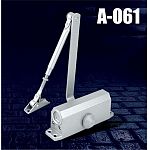
The Working Principle Of Door Closer
Oct 21, 2014
Modern hydraulic door closer achieve the buffer action by throttling the liquid in it. When the door is opened, the door drives connecting rod to act and rotates the drive gear, making the driving rack piston move to the right. In this process, the spring is compressed, as well as the hydraulic oil in the right cavity. The one-way valve ball in the left of plunger opens under the action of oil pressure, and hydraulic oil flow from right cavity to the left through the one-way valve. When the open process is complete, the elastic potential energy in the spring, which is caused by opening compression, will be released and push the plunger to the left, and drive the drive gear and the connecting rod to rotate, so that the door will be closed.
In the spring release process, because the hydraulic oil in the door closer’s left cavity is compressed and the one-way valve is closed, the hydraulic oil can only outflow through the gap between the shell and the plunger, and then flow back into the right cavity through holes on the plunger and two runners provided with throttling valve cores. Therefore, the hydraulic oil forms drag to the spring release, namely through the throttle reaches the buffering effect, making the door closing speed under control. And the throttle can be adjusted, which makes it is possible to control different travel section and change the closing speed.

| ©2013 Shanghai Teeryes Hardware Co.,Ltd All Right Reserved. |
